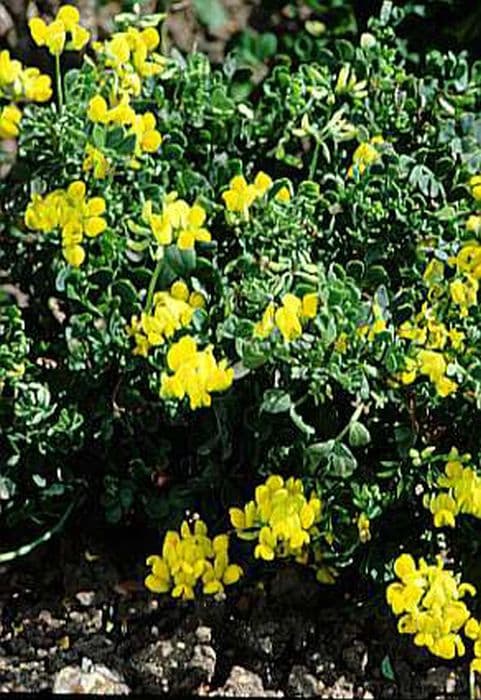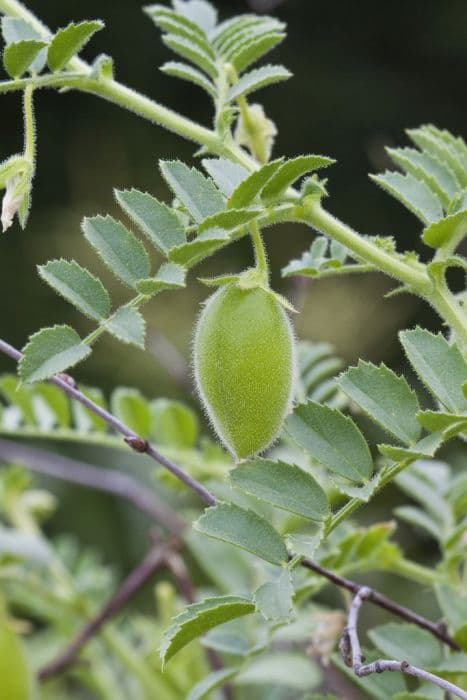Judas tree Cercis siliquastrum

ABOUT
Cercis siliquastrum, commonly known as the Judas tree, is a deciduous plant that is notable for its stunning spring display. It has a unique and eye-catching appearance thanks to its abundant flowering habit. During the bloom season, the branches and even the trunk can become completely covered in flowers. The flowers of the Judas tree are typically a deep pink to purplish color, and they are quite small individually. Despite their size, what makes them especially remarkable is that they grow directly on the wood of the branches, before the heart-shaped leaves unfold. These leaves appear shortly after the flowering period, revealing a bright green initially and maturing to a more subdued blue-green. In the fall, the foliage of the Judas tree transforms to a warm yellow, bringing a new layer of visual interest. Following the flowers, the plant produces seed pods that hang elegantly from the branches. These pods are long and flat, remaining on the tree well into the winter, providing textural and visual interest even when the leaves have fallen. The overall form of the Judas tree can vary quite strikingly, allowing it to often stand out in a landscape. It may develop a rounded, spreading canopy that allows the full splendor of its flowers to be displayed. The bark of the tree is smooth and dark, providing a striking contrast to the flowers and foliage, which further accentuates its ornamental value. From its distinctive flowering pattern to its heart-shaped leaves and changeable seasonal colors, the Judas tree is a compelling plant with a visually interesting and dynamic appearance. It is commonly planted for ornamental purposes and is appreciated for the remarkable beauty it brings to any space it occupies.
About this plant
 Names
NamesFamily
Fabaceae
Synonyms
Judas Tree, Love Tree, Mediterranean Redbud
Common names
Cercis siliquastrum.
 Toxicity
ToxicityTo humans
The Cercis siliquastrum, commonly known as the Judas tree, is not considered highly toxic to humans. Ingestion of parts of this plant is unlikely to cause serious poisoning. However, eating large quantities of the plant, particularly the seeds, could potentially result in discomfort or mild gastrointestinal upset, as with many other plants that are not typically consumed as food. Symptoms could include nausea, vomiting, or diarrhea. While it is not regarded as a dangerous plant to humans, it's still advisable to avoid consuming it and to keep an eye on children who might be attracted to its flowers or pods.
To pets
The Judas tree is also not known to be highly toxic to pets. Similar to humans, pets that ingest parts of this plant might experience mild gastrointestinal upset, which can include symptoms such as vomiting or diarrhea. It is generally not considered a plant that poses significant risks of poisoning to pets, but as with any non-food plant, consumption should be discouraged to prevent potential discomfort or more severe reactions in pets with sensitivities. If a pet is known to have ingested a substantial amount of the plant and is showing signs of illness, it is best to consult with a veterinarian.
 Characteristics
CharacteristicsLife cycle
Perennials
Foliage type
Deciduous
Color of leaves
Green
Flower color
Pink
Height
15-25 feet [4.6-7.6 meters]
Spread
10-15 feet [3-4.5 meters]
Plant type
Tree
Hardiness zones
6-9
Native area
Mediterranean
Benefits
 General Benefits
General Benefits- Aesthetic Appeal: Cercis siliquastrum, commonly known as the Judas tree, is widely appreciated for its stunning spring blossoms that provide aesthetic appeal to gardens and landscapes.
- Habitat for Wildlife: It offers a valuable habitat and food source for a variety of wildlife, including bees and other pollinators which are attracted to its flowers.
- Shade and Cooling: The tree provides shade during the hotter months, creating cooler microclimates that can be beneficial for both people and understory plants.
- Ornamental Landscaping: Due to its unique and striking appearance, with heart-shaped leaves and an often multi-trunked structure, it is commonly used for ornamental purposes in landscaping projects.
- Seasonal Interest: With its springtime blossoms, summer foliage, and sometimes colorful autumn leaves, the Judas tree adds seasonal interest to any outdoor space.
- Erosion Control: The root system of Cercis siliquastrum can help stabilize soil and prevent erosion on slopes or in areas susceptible to soil degradation.
- Drought Tolerance: Once established, the Judas tree can tolerate periods of drought, making it suitable for xeriscaping and low-water-use gardens.
- Cultural and Historical Significance: The Judas tree has a rich cultural and historical background, with legends and folklore associated with it, which can add an element of interest and education to gardens and parks.
 Medical Properties
Medical Properties- Anti-inflammatory: Cercis siliquastrum, commonly known as Judas tree, has been used traditionally to reduce inflammation.
- Astringent: The plant has astringent properties and may help in wound healing by contracting skin cells.
 Air-purifying Qualities
Air-purifying QualitiesThis plant is not specifically known for air purifying qualities.
 Other Uses
Other Uses- Judas tree wood is often used for carving and turning, as it is hard and dense, making it suitable for small wooden objects and decorative items.
- The flowers of the Judas tree can be eaten in salads for a splash of colour and a slightly acidic flavor, adding a unique touch to culinary presentations.
- In traditional carpentry, the wood of the Judas tree, being fine-grained and firm, was occasionally used for inlay work or for making small cabinets.
- The tree's dense canopy provides shade and is often planted in parks and gardens for its aesthetic appeal throughout the seasons.
- The abundant nectar from the blossoms of the Judas tree attracts bees, making it a valuable plant for supporting local pollinators and enhancing biodiversity.
- Landscapers make use of the tree's striking purple-pink flowers to create dramatic springtime displays in urban and suburban settings.
- The leaves of the Judas tree can be used as fodder for livestock, particularly in regions where other fodder may be scarce.
- Dye extracted from the flowers and bark of the Judas tree has been used historically for colouring textiles and artworks.
- As a compact ornamental tree, it's often used in bonsai cultivation for its interesting structure and early spring blossoms.
- The branches and twigs of the Judas tree can be used in floral arrangements, especially during the early spring when the tree blooms before its leaves appear.
Interesting Facts
 Feng Shui
Feng ShuiThe Judas tree is not used in Feng Shui practice.
 Zodiac Sign Compitability
Zodiac Sign CompitabilityThe Judas tree is not used in astrology practice.
 Plant Symbolism
Plant Symbolism- Love and Affection: Commonly known as the Judas tree, Cercis siliquastrum is associated with love and affection. This is due to the heart-shaped leaves, which are emblematic of love and the human heart.
- Renewal and Resurrection: The tree often blooms with vibrant pink flowers during the springtime, symbolizing the idea of renewal and the resurrection of nature after the winter.
- Spirituality: In Christian legend, it is said that Judas Iscariot hanged himself from a tree of this species after betraying Jesus, which gives it spiritual associations with repentance and suffering.
- Beauty: The striking appearance of its flowers makes the Judas tree a symbol of natural beauty and the aesthetic pleasures of the natural world.
 Water
WaterThe common name for Cercis siliquastrum is the Judas tree. It is best to water this tree deeply and infrequently, ensuring the soil is moist but not waterlogged. During its growing season in spring and summer, water the tree with about 1-2 gallons every week, depending on rainfall and temperatures. Reduce watering in the fall and further once the tree is dormant in winter, watering only if there's a prolonged dry spell. Always check the soil moisture before watering to avoid overwatering, which can lead to root rot.
 Light
LightThe Judas tree thrives best in full sun to partial shade conditions. The ideal spot for planting it would be an area that receives at least six hours of direct sunlight daily, while offering some protection from the intense afternoon sun. This balance encourages healthy growth and flowering.
 Temperature
TemperatureThe Judas tree is adaptable to a wide range of temperatures but performs best in USDA zones 6 through 9. It can survive minimum temperatures of -10 to 0 degrees Fahrenheit and maximum temperatures typical of temperate climates. The ideal temperature range for flourishing growth is between 50 and 80 degrees Fahrenheit.
 Pruning
PruningPruning the Judas tree is important to maintain its shape and to remove any dead or diseased wood. It is best done in late winter or early spring before new growth starts, as this is when the tree is dormant. It's also a good time to prune to encourage flowering and to shape the young trees. Generally, pruning should be carried out sparingly, as the Judas tree does not respond well to heavy cutting.
 Cleaning
CleaningAs needed
 Soil
SoilJudas tree thrives in well-draining soil with a pH between 6.0 and 7.5. An ideal mix would be equal parts garden soil, compost, sand, and peat to ensure good drainage and fertility. Additionally, a layer of mulch can help retain moisture and regulate soil temperature.
 Repotting
RepottingJudas trees do not typically need frequent repotting as they are relatively slow-growing. They should be repotted every 3 to 5 years to refresh the soil and accommodate the growth of the plant. It's best to repot in the spring before the growth season begins.
 Humidity & Misting
Humidity & MistingJudas tree prefers moderate humidity but is quite adaptable and can tolerate a range of humidity levels. It does not require any special humidity conditions when planted outdoors, as it is relatively tolerant of different climate conditions.
 Suitable locations
Suitable locationsIndoor
Judas tree rarely grown indoor; need ample light.
Outdoor
Plant in full sun to partial shade in well-drained soil.
Hardiness zone
6-9 USDA
 Life cycle
Life cycleCercis siliquastrum, commonly known as the Judas tree, begins its life as a seed, which, when conditions are right—typically in spring—germinates and develops into a seedling. As the seedling grows, it establishes a root system and a shoot that develops into a small tree, experiencing rapid vegetative growth. The Judas tree can then take several years to mature and reach the flowering stage, where it produces its characteristic pink or purple flowers in early spring before the leaves fully expand. Following the bloom, the tree develops seed pods, which mature over the summer and persist on the tree into winter. These hard, bean-like pods eventually open to release seeds, completing the reproductive cycle. Once mature, the Judas tree can survive for many years, flowering annually and producing seeds to ensure the continuation of the species.
 Propogation
PropogationPropogation time
Spring to Summer
The most popular method for propagating the Judas tree, Cercis siliquastrum, is by seed. Generally, it's best to collect the seeds in the fall when the pods have dried on the tree. To increase the chances of germination, seeds require pre-sowing treatment by soaking in warm water for 24 hours to soften the hard outer seed coat. Following this, sowing should be done in a cold frame during winter, which provides a period of cold stratification necessary for germination. Seeds should be planted at a shallow depth, approximately 1/4 inch deep (about 6 millimeters), in well-draining soil. With the warmth of spring, the stratified seeds will usually germinate, and the seedlings can be grown in pots until they are strong enough to be planted in their final location.







![Kowhai [Sun King]](/_next/image?url=https%3A%2F%2Fplants-admin.emdemapps.com%2Fimages%2Fplants%2F%2Fimages%2F604b57cb7f598.png&w=640&q=75)

